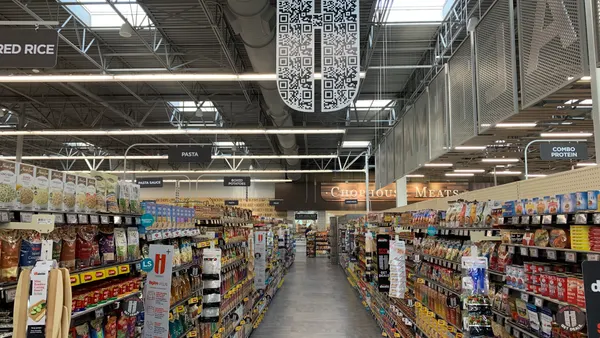Dive Brief:
- E-commerce at Walmart was up 24% in the second quarter. The retailer also reported global revenue of $161.6 billion, a 5.7% rise year over year, in a Thursday morning earnings announcement.
- Comparable sales for Walmart in the U.S. were up 6.4% for the quarter, while net sales were up 5.4% to $110.9 billion and operating income rose 6.7% to $7.3 billion.
- Walmart said it sees strength across segments in its omnichannel model and that consumers continue to respond to economic pressures by spending on essentials versus discretionary items. “We see people across income cohorts come to us more frequently, looking to save money on everyday needs,” CEO Doug McMillon said.
Dive Insight:
McMillon said rising borrowing costs, rising energy prices and the resumption of student loan payments all mean that household budgets are still under pressure. At Walmart, the outcome is that consumers are spending more on private brand grocery staples and purchases to support more in-home meal options, like kitchenware and small appliances.
Connecting with value-conscious consumers “gives us an opportunity to drive conversion in more discretionary categories,” McMillon said. “We’re encouraged by how general merchandise performed during the second quarter versus our expectations.” And trends the company sees in general merchandise “make us feel more optimistic about those categories in the back half of the year.”
Walmart’s long-standing focus on value appeals to cost-conscious consumers, which in turn benefits the company during this ongoing period of inflation, Insider Intelligence senior analyst Zak Stambor said in emailed comments. “Walmart grocery and wellness sales help insulate it from consumers’ pullback in discretionary spending. That’s a marked difference from Target, which helps explain the stark contrast between the two companies’ Q2 results.”
McMillon also said Walmart’s in-store-fulfillment and same-day delivery is growing. More than 4,000 Walmarts, 600 Sam’s Club stores and 2,000 of the company’s international stores now make same-day deliveries, he said.
“We’re increasingly measuring those deliveries in hours rather than days,” McMillon said, adding that improved delivery speed is “important to our customers and to our strategy.” Stambor echoed McMillon’s take on the importance of delivery to the company’s bottom line.
“While Walmart’s primary value proposition has long been its low prices, its strong e-commerce growth shows it is also winning over shoppers who are looking for convenience with its range of pickup and delivery options,” said Stambor.
Walmart CFO John David Rainey said the company’s financial performance validates its omnichannel strategy, is driving organic sales growth and improving margins and returns. With that context, Rainey said the company is raising its quarterly and full-year guidance based on the last quarter’s performance.
Analysts with Roth MKM led by Bill Kirk said in a note published before the earnings call that Walmart's updated guidance surpassed analyst expectations. The company now forecasts that its consolidated net sales will rise about 3% for the next quarter and consolidated operating income will rise about 1%.
For the year, Walmart expects net sales to rise 4% to 4.5% and overall operating income to increase 7% to 7.5%. The updated guidance is based on previously disclosed fiscal year 2023 figures of $605.9 billion in net sales and adjusted operating income of $24.6 billion.
As the company enters the second half of the year, a handful of people will step into new leadership roles.
Judith McKenna, president and CEO of Walmart International, is retiring after 27 years with the company. Kath McLay, formerly CEO of Sam’s Club, will become president and CEO of Walmart International. In McLay’s place, Chris Nicholas will become the new president and CEO of Sam’s Club U.S. The leadership changes are effective on Sept. 11. In addition, Walmart said this week that Kieran Shanahan will succeed Nicholas as executive vice president and chief operating officer of Walmart U.S.













